The Desert Northwest
Botanical Expedition to Chelan County, Washington
October 2011
Page 1 | Page 2 >>
For several years now, I have been pretty tied to home and the nursery. However, I have increasingly felt like it is worth getting out more to explore for plants even if I can't go very far or for very long. So finally the first weekend of October 2011 I managed to round up the family for a quick getaway to Chelan County, Washington. This was the perfect time of year to visit, as the weather was certainly far nicer over there than it was in Western Washington that weekend and very pleasant overall.
So what's so exciting about Chelan County, you might be wondering? You might think it is all just ponderosa pines and sage brush (which are cool, anyways). But in fact Chelan County is somewhat of a hotspot for floral diversity in the state of Washington, being one of the places where the dryland flora of Central Washington's deserts meets with the alpine and subalpine plants the grow on the drier east slope of the Cascades. Then there is Lake Chelan, which penetrates deeply into the mountains at such a low altitude that it creates a unique microclimate harboring refugia for certain plants far away from their main centers of distribution (notably Pellaea brachyptera, Sierra cliffbrake; and Arctostaphylos patula, greenleaf manzanita). Genera such as Penstemon and Eriogonum are found in many diverse forms here. With so much variation in climate and terrain (from 9,511' down to about 650') this region is certainly a potential gold mine for valuable drought tolerant garden plants, with the added benefit of being able to assure that all of these plants will be cold-hardy west of the Cascades – something gardeners have been increasingly concerned about following the last few colder winters.
To start with we drove over Highway 2 towards central Washington, and I saw lots of great Arctostaphylos nevadensis, but I did not stop for photos since I assumed I would see plenty of it later. However I did not see this more 'typical form' of the species again.
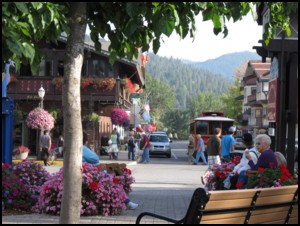
|
Despite having been rained on a bit in western Washington, it was sunny and probably in the upper 70's as we passed through the little town of Leavenworth just in time for the first day of Oktoberfest. Leavenworth takes advantage of its rugged mountainous surroundings to present itself as a Bavarian-themed tourist trap. We didn't stay long here – although there are some very interesting and rare plants in this area such as Lewisia tweedyi and Larix lyallii, we decided to pass them by for a later trip – also, some of the best sites of botanical interest are probably not very accessible.
|

|
In Leavenworth, even the grocery chain Safeway is required to conform to Bavarian-style building codes, apparently.
|
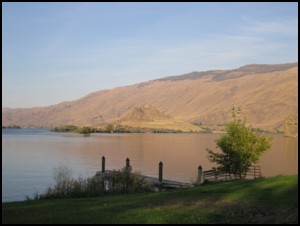
|
This was our campsite at Lincoln Rock State Park. At $21 per night it is an expensive place to camp but the setting is beautiful, and it was great to be back in the desert. I couldn't help but notice, however, that irrigating all this grass must use a ton of water, and none of the planted shade trees were native species – Quercus coccinea (scarlet oak), a completely inappropriate tree for Central Washington, and Pinus nigra (Austrian pine) dominated the campground. We woke up to temperatures in the upper 50's both days.
|
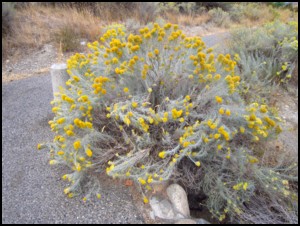
|
Near the campground were growing in abundance some Ericameria nauseosa, or rabbit-brush. This plant with great silvery color is widespread in the Wenatchee area (and apparently in much of Eastern Washington) but I have never once seen it in nurseries or gardens on the west side. It may like it drier but I would be surprised if it were not growable on a well-drained sunny site west of the Cascades.
|
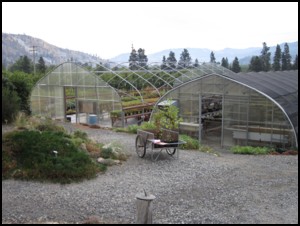
|
Our first stop the following morning was Derby Canyon Natives, a nursery in Peshastin specializing in a wide range of plants native to the surrounding region, and a few other odds and ends, with an emphasis on small plugs for habitat restoration. As they were propagating a wide range of valuable dryland flora, I found the place to be quite interesting and purchased some plants.
|
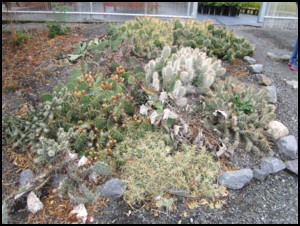
|
Bed of (not strictly native) hardy cacti at Derby Canyon Natives.
|
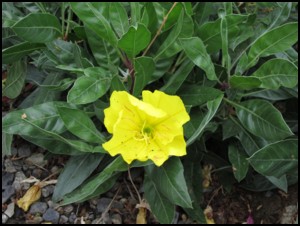
|
Oenothera species in flower at Derby Canyon Natives. It was suggested that we return in May when everything is blooming, but that is the wrong time of year for cuttings and seeds.
|
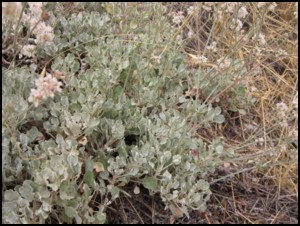
|
In the town of Entiat we found some nice Eriogonums including this E. strictum (I think ???) with slightly undulate leaves. We also found a nice blue-foliaged one which may be E. niveum. The Eriogonums (buckwheats) are a valuable group of plants that is seldom offered by nurseries yet quite easy to grow; in fact, I have had E. umbellatum in Olympia for many years and the heavy rain doesn't faze it too much.
|
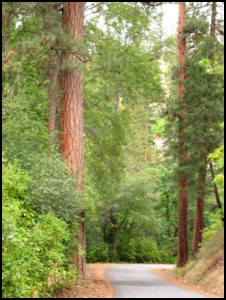
|
We followed the Entiat River up to Ardenvoir, then turned up the Mad River Rd. in search of an (apparently) very isolated occurrence of Ceanothus prostratus, a species known from just one record in Chelan County, and occasionally found in Klickitat County; but relatively common from the Mt. Hood area of Oregon south into California. As we drove farther up the river the Ponderosa pines got bigger and more impressive. The problem with planting one, though, is that to get the awesome bark like this you have to wait about 150 years!
|
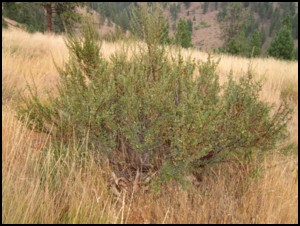
|
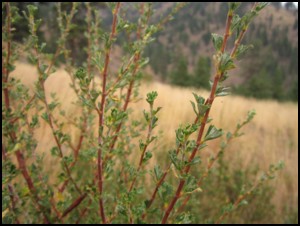
|
Now at 2,400', Purshia tridentata is an interesting, and, in my opinion, very nice looking shrub in the Rosaceae family, yet again I never see it in nurseries or gardens on the West Side. I am sure it would grow easily in a well-drained spot, since it is not exclusively a desert plant and occurs to at least 4,000' on the east slopes of the Cascades.
|
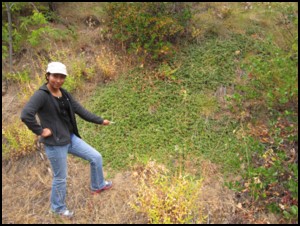
|
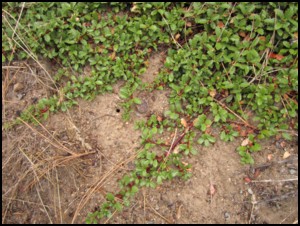
|
At 2,700', Madelin spotted the plant we were looking for just as I almost drove by it, earning her the Awesome Plant Hunter Award for the trip! OK, so Ceanothus prostratus doesn't look terribly exciting out of bloom, but it was great to see this plant looking so healthy quite a few years after the initial report of its existence. Is this the only one? We didn't see any more and one would have to spend more time searching the area to find out.
|
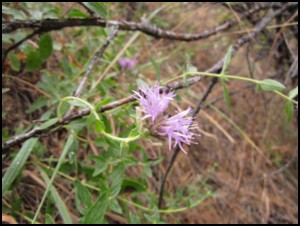
|
Also found at the same site was this attractive Monardella odoratissima - the flower color was actually a darker lavender than my camera could capture. Someone has probably selected better cultivated forms of this but again it was cool just to see it.
|
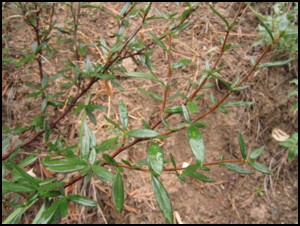
|
Another ornamentally valuable and very hardy evergreen shrub, Cercocarpus ledifolius (mountain mahogany) was growing right next to it as well. Although we weren't looking for this, it is apparently also a widely disjunct (and probably also the most northerly) occurrence for its species, the closest recorded plants being in the Blue Mountains in the southeast corner of the state.
|
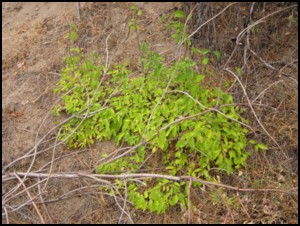
|
And Philadelphus lewisii was common here, though this is slightly less exciting since it is common in a lot of places. In Chelan County though one comes to appreciate how well this plant performs on hot, dry sites: it is not really a woodland plant as people often seem to think.
|
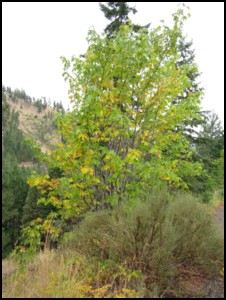
|
Many gardeners are unaware that Acer macrophyllum grows in several locations east of the Cascades, most notably along Lake Chelan, where it grows into giant tree size at both ends of the lake, in the Entiat Valley (pictured here), south of Peshastin, and also in Klickitat County as far east as Maryhill. Yet most references consider this tree to be hardy only to USDA zone 6 (-10°F) and Sunset rates it for west of the Cascades only. Whatever. Seed from these trees ought to result in much hardier plants than usual. The association with Purshia tridentata (foreground) seems most unusual for gardeners who think of Acer macrophyllum as a rainforest tree!
|
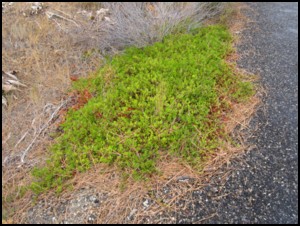
|
Here's a groundcover Arctostaphylos with the prostrate habit of A. uva-ursi (kinnikkinnik) but with lighter green foliage and pointier leaves characteristic of A. nevadensis. A. uva-ursi and A. nevadensis get really tough to distinguish in certain places: I think one would have to call this A. nevadensis but we may have to wait and see flowers and fruit to be certain. In any case, the Arctostaphylos were to get a lot more interesting very soon.
|
Page 2 >>
|

















